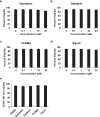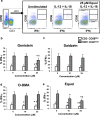Soy isoflavones and their metabolites modulate cytokine-induced natural killer cell function
- PMID: 30911044
- PMCID: PMC6433892
- DOI: 10.1038/s41598-019-41687-z
Soy isoflavones and their metabolites modulate cytokine-induced natural killer cell function
Abstract
Soybeans are a rich source of isoflavones that have been linked with anti-inflammatory processes and various health benefits. However, specific mechanisms whereby soy bioactives impact immune cell subsets are unclear. Isoflavones, such as genistein and daidzein, are metabolized by microbes to bioactive metabolites as O-desmethylangolensin (O-DMA) and equol, whose presence has been linked to health benefits. We examined how soy isoflavones and metabolites impact natural killer (NK) cell signaling and function. We observe no impact of isoflavones on viability of healthy donor peripheral blood mononuclear cells (PBMCs) or NK cells, even at high (25 µM) concentrations. However, pre-treatment of PBMCs with physiologically-relevant concentrations of genistein (p = 0.0023) and equol (p = 0.006) decreases interleukin (IL)-12/IL-18-induced interferon-gamma (IFN-γ) production versus controls. Detailed cellular analyses indicate genistein and equol decrease IL-12/IL-18-induced IFN-γ production by human NK cell subsets, but do not consistently alter cytotoxicity. At the level of signal transduction, genistein decreases IL-12/IL-18-induced total phosphorylated tyrosine, and phosphorylation MAPK pathway components. Further, genistein limits IL-12/IL-18-mediated upregulation of IL-18Rα expression on NK cells (p = 0.0109). Finally, in vivo studies revealed that C57BL/6 mice fed a soy-enriched diet produce less plasma IFN-γ following administration of IL-12/IL-18 versus control-fed animals (p < 0.0001). This study provides insight into how dietary soy modulates NK cell functions.
Conflict of interest statement
Dr. Lesinski has consulted for ProDa Biotech, LLC and received compensation. Dr. Lesinski has received research funding through a sponsored research agreements between Emory University and Merck and Co., Inc., Boehringer Ingelheim, Inc., Bristol Myers Squibb, Inc. and Vaccinex, Inc. that are not related to this work. All other authors declare no conflicts of interest.
Figures








Similar articles
-
The soy isoflavone equol enhances antigen-specific IgE production in ovalbumin-immunized BALB/c mice.J Nutr Sci Vitaminol (Tokyo). 2010;56(1):72-6. doi: 10.3177/jnsv.56.72. J Nutr Sci Vitaminol (Tokyo). 2010. PMID: 20354350
-
Improvement of Colonic Immune Function with Soy Isoflavones in High-Fat Diet-Induced Obese Rats.Molecules. 2019 Mar 22;24(6):1139. doi: 10.3390/molecules24061139. Molecules. 2019. PMID: 30909396 Free PMC article.
-
Metabolism of the soy isoflavones daidzein and genistein by fungi used in the preparation of various fermented soybean foods.Biosci Biotechnol Biochem. 2007 May;71(5):1330-3. doi: 10.1271/bbb.60573. Epub 2007 May 7. Biosci Biotechnol Biochem. 2007. PMID: 17485838
-
Metabolism of dietary soy isoflavones to equol by human intestinal microflora--implications for health.Mol Nutr Food Res. 2007 Jul;51(7):765-81. doi: 10.1002/mnfr.200600262. Mol Nutr Food Res. 2007. PMID: 17579894 Review.
-
Isoflavones, equol and cardiovascular disease: pharmacological and therapeutic insights.Curr Med Chem. 2007;14(26):2824-30. doi: 10.2174/092986707782360178. Curr Med Chem. 2007. PMID: 18045128 Review.
Cited by
-
Genistein: A Review on its Anti-Inflammatory Properties.Front Pharmacol. 2022 Jan 24;13:820969. doi: 10.3389/fphar.2022.820969. eCollection 2022. Front Pharmacol. 2022. PMID: 35140617 Free PMC article. Review.
-
Isoflavones in Soybean as a Daily Nutrient: The Mechanisms of Action and How They Alter the Pharmacokinetics of Drugs.Turk J Pharm Sci. 2021 Dec 31;18(6):799-810. doi: 10.4274/tjps.galenos.2020.79106. Turk J Pharm Sci. 2021. PMID: 34979737 Free PMC article.
-
Genistein alleviates colitis by suppressing inflammation and modulating colonic Marvinbryantia formatexigens abundance and metabolites.Curr Res Food Sci. 2025 Mar 10;10:101016. doi: 10.1016/j.crfs.2025.101016. eCollection 2025. Curr Res Food Sci. 2025. PMID: 40207203 Free PMC article.
-
Antidiabetic Activity of Mung Bean or Vigna radiata (L.) Wilczek Seeds in Alloxan-Induced Diabetic Mice.Evid Based Complement Alternat Med. 2022 Oct 26;2022:6990263. doi: 10.1155/2022/6990263. eCollection 2022. Evid Based Complement Alternat Med. 2022. PMID: 36337582 Free PMC article.
-
Transcriptomic analysis reveals the immune response of human microglia to a soy protein and collagen hybrid bioscaffold.Heliyon. 2023 Feb 1;9(2):e13352. doi: 10.1016/j.heliyon.2023.e13352. eCollection 2023 Feb. Heliyon. 2023. PMID: 36825181 Free PMC article.
References
Publication types
MeSH terms
Substances
Grants and funding
LinkOut - more resources
Full Text Sources

